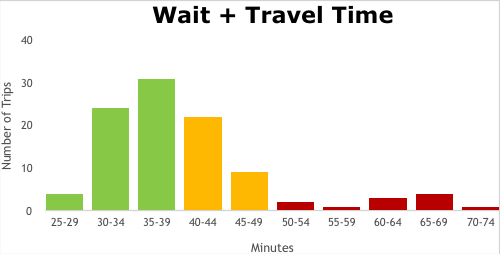Is The Bus “always late?” No. Not even close.
“This bus is always late.” People say it so often while waiting for Prince George’s County’s The Bus that it’s basically become a conversation starter. But I tracked my last 101 trips on The Bus, and my bus was either on time or very close to it 86% of the time. That’s a lot better than what common complaints suggest.
I’ve been tracking each of my trips to and from work on The Bus since December of last year. For each, I noted the time I arrive at the bus stop, the time the bus left the stop, and the time I exited the bus. I compared this with the scheduled arrival times to see how much time I spent waiting, how many minutes the bus was late (or on-time), how many minutes I spent traveling on the bus, and the total travel time (the wait time + the travel time).
Generally, transit agencies consider buses to be on time if the bus arrives at a stop between one minute before or up to five minutes after the scheduled time. For the 101 trips tracked, my bus was on time by definition 75.2% of the time (76 trips)— 36 of the trips were exactly on time. On average, my bus arrived at the stop 3.4 minutes after the scheduled time.
My bus was 5-9 minutes late 9.9% of the time (10 trips). That’s technically late, but the wait isn’t bad. It isn’t until the bus is more than 10 minutes late that using transit becomes noticeably inconvenient. Of the 101 tracked trips, there were 11 trips where the bus was later than 10 minutes.
Unfortunately, when I recall my transit trips, the longest waits are the trips I remember most easily.
Knowing how long my commute will take is key to scheduling my day and making transit convenient. On average, I spent approximately 10.8 minutes waiting for the bus. The average time spent on the bus was approximately 29.2 minutes. Together, the average total trip time was 40.1 minutes and 80.1% of the trips were under 45 minutes, which is the amount of time I set aside to ride The Bus.
Although the length of my bus commute is less than ideal, the expected wait time and travel time is fairly consistent, and I can easily fit my bus schedule into my daily work schedule.
The Bus does not always run perfectly, but claiming that it is always late is simply not true. Based on the last 101 trips, The Bus is a generally predictable and dependable transit service. For a transit service that’s outside of an urban environment and whose resources are constrained, The Bus is a solid service. Among some of its key strengths:
- Dispatch number. All stops list a contact number you can call during business hours, and a helpful live dispatcher can find out exactly where a bus is and when it’s expected to arrive. Some stops also have countdown timers, which help inform users when to expect the next bus.
- Professional and positive bus operators. Operators for The Bus are friendly and perform their duties with a high level of care, respect, and customer service, often while responding to frustrated and discourteous riders.
I’ve also got some thoughts on how The Bus could get better:
- Add The Bus to online mapping apps. The Bus is not currently on Google Maps, Apple Maps, or other transportation apps. This makes it very difficult to plan a trip on The Bus without reviewing all of the timetables. However, the County is in the process of collecting the GTFS data and it is possible that The Bus will be available on transit apps later this year.
- Higher frequencies, especially during the peak. It’s expensive for any transit service to run buses more often, and will be a definite challenge for Prince George’s County. But a late bus feels especially inconvenient when the next bus isn’t arriving for another half hour.
- Early buses. These are a double-edged sword: While it’s great to arrive at a stop early, leaving a stop early means passengers who arrive on time have to wait for the next bus. It’s helpful when drivers wait until the scheduled time to leave.
Bus transit in non-urban areas has to serve low densities of people over long distances; making it work can be difficult. Prince George’s County provides a reliable service to many areas of the county that are not easily accessible without an automobile and helps connect to the regional rail and bus services.



